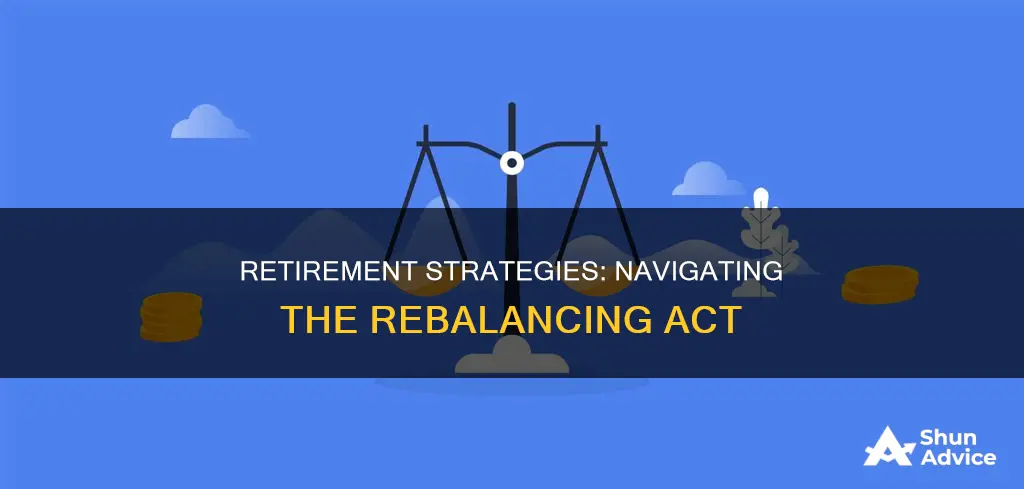
Retirement planning is a complex process that requires careful consideration and expertise. One crucial aspect of retirement planning is periodically rebalancing your investment portfolio to ensure it aligns with your risk tolerance and financial goals. This process involves adjusting your portfolio by buying and selling assets to maintain the desired level of investment risk. For example, if you initially set your portfolio to have 70% stocks and 30% bonds, but the stock market performs exceptionally well, you may end up with a portfolio that has 80% stocks and 20% bonds. To rebalance, you would sell a portion of your stocks and use the proceeds to buy more bonds, bringing your portfolio back to the desired 70-30 ratio.
There are different approaches to determining when to rebalance your portfolio. One method is to do it at specific time intervals, such as annually or quarterly. Another approach is to rebalance only when your portfolio deviates significantly from your desired allocation, for instance, when a particular asset class deviates from the planned allocation by 20% or more.
It's important to consult a financial advisor or expert to determine the best rebalancing strategy for your specific situation, as there are various factors to consider, including your risk tolerance, investment goals, and market conditions.
What You'll Learn

The importance of rebalancing your portfolio
Rebalancing your portfolio is a critical aspect of investment management. It involves adjusting the weightings of different assets to realign with your financial goals, risk tolerance, and desired asset allocation. Here are some key reasons why rebalancing your portfolio is essential:
Maintain Your Risk Profile:
By rebalancing, you ensure that your portfolio's risk profile remains consistent with your comfort level and investment strategy. Over time, as certain assets outperform others, your portfolio can become overweight in riskier investments or deviate from your intended allocation. Rebalancing helps you proactively manage this risk.
Optimise Returns:
Rebalancing can potentially enhance your portfolio's returns. By periodically buying and selling assets, you may be able to take advantage of market fluctuations. For example, by selling a portion of an asset class that has performed well and using the proceeds to invest in an underperforming asset class, you are effectively selling high and buying low, which is a fundamental investing strategy.
Stay on Track with Financial Goals:
Rebalancing helps ensure that your investment portfolio remains aligned with your financial objectives. Whether you are saving for retirement, a child's education, or any other financial goal, rebalancing ensures that your portfolio is structured to meet those goals. It allows you to make rational, data-driven adjustments rather than reacting emotionally to market volatility.
Adapt to Life Changes:
Major life events, such as retirement, the birth of a child, or a health crisis, may warrant a reevaluation of your investment strategy. Rebalancing allows you to adjust your portfolio to accommodate these life changes and ensure that your investments continue to work for you.
Mitigate Volatility:
Market volatility can cause your portfolio to deviate from your target asset allocation. By rebalancing, you can mitigate the impact of market highs and lows, ensuring that your portfolio doesn't become too heavily weighted in one type of asset. This helps to smooth out the highs and lows of your portfolio's performance.
In conclusion, rebalancing your portfolio is a necessary task for any investor. It helps you maintain control over your investments, ensuring they align with your risk tolerance, financial goals, and desired asset allocation. While the process may involve costs and taxes, the benefits of rebalancing can help you stay on course toward a secure financial future.
The Smart Money Move: Pay Off Debt or Invest?
You may want to see also

How to rebalance your portfolio
Rebalancing your portfolio means buying and selling assets to maintain your desired level of investment risk. This can help keep you on track to meet your goals and may enhance your portfolio's returns.
Traditional Rebalancing
An asset allocation plan guides you on how to distribute your investments across different asset classes, such as stocks, bonds, and cash. Each desired allocation is expressed as a percentage, and you maintain these investment ratios by rebalancing on a predetermined basis, perhaps once a year.
For example, if your original risk tolerance led you to invest 70% of your money in stocks, then your rebalanced portfolio should be 70% stocks once again. This can be achieved by selling some of your stock investments and putting the money into bonds or buying more bonds to realign your asset allocation with your risk tolerance.
When to Rebalance
There are two general approaches to how often you should rebalance your portfolio. The first is based on time. For example, you might rebalance your portfolio once a quarter, once every six months, or once a year. The second approach is to rebalance based on tolerance thresholds. For instance, you might rebalance an asset class when its allocation deviates from the planned allocation by 20% or more.
Rebalancing in Retirement
It's important to discuss your retirement plans with your financial planner at least a year or two before retiring, and preferably in the two to five years leading up to retirement. You need to decide when you need to begin withdrawals, as this will impact how you rebalance.
In retirement, you should rebalance at least annually. How often you rebalance will depend on how aggressively your portfolio is invested. Typically, you should look to see if the holdings in your portfolio have gone out of balance by a specific percentage, with 5% being a good threshold to start with.
Retirement Planning: Overcoming Investment Inertia
You may want to see also

When to rebalance your portfolio
The first approach is based on time. You might rebalance your portfolio once a quarter, once every six months, or once a year. This approach is simple and removes psychological factors that can cause investors to make changes during extreme market fluctuations.
The second approach, recommended by many financial advisors, is to rebalance based on tolerance thresholds. For example, you might rebalance when an asset class deviates from the planned allocation by 20% or more. Using this method, you set a specific threshold for when to rebalance, which can help to remove emotions from the decision-making process.
It is recommended to rebalance your portfolio at least annually, especially if you are close to retirement, to ensure it still aligns with your risk tolerance and long-term financial goals. However, if your portfolio's value is extremely volatile, you may need to rebalance more frequently, such as once or twice a year.
Additionally, changes in your lifestyle or risk tolerance may warrant changes to your asset allocation strategy. It is important to monitor your financial situation and adjust your portfolio as circumstances change over time.
Retirement Investing: Strategies for a Secure Future
You may want to see also

How often to rebalance your portfolio
How often you should rebalance your portfolio depends on your personal preferences, financial goals, and risk tolerance. While there is no one-size-fits-all answer, here are some general guidelines and factors to consider:
Frequency of Rebalancing
You can choose to rebalance your portfolio at regular intervals, such as monthly, quarterly, biannually, or annually. The advantage of using a time-based approach is that it helps you develop a rebalancing habit, ensuring you don't forget to do it. Additionally, during the rebalancing process, you may also review other aspects of your portfolio, such as expense ratios and commissions.
On the other hand, you can opt for a more flexible approach by rebalancing only when your asset allocation reaches a specific tipping point. For example, if your target allocation is 80% stocks and 20% bonds, you may decide to rebalance whenever the stock portion of your portfolio deviates by more than 5% or 10% from this target. This approach ensures that your portfolio doesn't remain off-kilter for extended periods.
Regardless of the method you choose, avoid overdoing it. Rebalancing too frequently may lead to unnecessary transaction costs and investment fees, especially if the changes in your asset allocation are minimal.
Life Stage and Risk Tolerance
The stage of life you're in and your risk tolerance will also influence how often you should rebalance. For example, younger investors who are more comfortable with risk may opt for a portfolio with a higher allocation of stocks and rebalance less frequently. On the other hand, older investors or those closer to retirement may want to rebalance more often as a risk-avoidance strategy, gradually shifting their portfolio towards more conservative investments.
Market Conditions
Current market conditions and economic trends can also impact the frequency of rebalancing. For instance, during periods of high market volatility or significant changes in interest rates, you may need to rebalance more often to avoid potential losses or take advantage of emerging opportunities.
Automatic Rebalancing Options
If you invest through a robo-advisory service or an employer-sponsored retirement plan, your portfolio may be automatically rebalanced for you. Target-date funds, for example, automatically adjust their asset allocation based on your target retirement date. This can save you time and effort in monitoring and rebalancing your portfolio manually.
In conclusion, deciding how often to rebalance your portfolio is a personal decision that depends on various factors. It's important to strike a balance between maintaining your desired asset allocation and avoiding unnecessary costs and fees. Regularly reviewing your portfolio and consulting with a financial advisor can help you determine the optimal rebalancing frequency for your specific circumstances.
The Investment Banker's Early Retirement Dream: Fantasy or Reality?
You may want to see also

What to include in your retirement portfolio
When it comes to retirement planning, creating a savings plan is the first step. The next step is to choose the right mix of investments, also known as a portfolio allocation. This allocation should be reviewed and rebalanced regularly to ensure it aligns with your goals, risk tolerance, and time horizon. Here are some key considerations for what to include in your retirement portfolio:
Stocks
Stocks are an important part of a retirement portfolio, regardless of age. They offer the potential for higher returns compared to other asset classes and help keep your portfolio inflated to counter the effects of inflation. However, stocks can be more volatile, so it's important to balance them with other investments.
Bonds
Bonds are typically considered safer than stocks and can provide a steady income stream. They are suitable for investors seeking a more conservative approach or those in their later years of retirement. Bond ladders, which involve purchasing bonds with staggered coupon and maturity dates, can help even out portfolio yields and provide consistent income.
Cash and Cash Equivalents
Having a year's worth of cash on hand at the start of each year is recommended to supplement your income from other sources. This can be held in a safe, liquid account, such as an interest-bearing bank account or money market fund. Additionally, it is wise to maintain a short-term reserve equivalent to two to four years' worth of living expenses in short-term bonds, certificates of deposit (CDs), or other liquid accounts.
Real Estate
Real estate can be a good investment for generating income or long-term appreciation. However, it is relatively illiquid, so it may be challenging to sell quickly if needed.
Commodities
Commodities like oil, gold, and wheat can provide diversification benefits and protect against inflation.
Dividend-Paying Stocks
Dividend-paying stocks offer a regular stream of income while allowing your principal to remain invested for potential growth.
Target-Date Funds
These funds automatically adjust their asset allocation over time, becoming more conservative as the target retirement date approaches. They are a convenient way to manage your portfolio as you get closer to retirement.
Balanced Funds
Balanced funds typically invest in a mix of stocks and bonds, focusing on income generation and capital appreciation. They are suitable for investors seeking a comfortable retirement without taking on excessive risk.
Growth Funds
Growth funds primarily invest in stocks, aiming for quick capital appreciation. They are suitable for investors with a high-risk tolerance and a long-term investment horizon.
Income Funds
Income funds focus on generating income by investing primarily in bonds and other income-producing assets.
Robo-Advisors
Robo-advisors are digital platforms that manage your portfolio based on preset algorithms. They tend to be more affordable than human advisors but may lack the ability to deviate from their programs in certain situations.
Remember, the specific allocation of these investments will depend on your age, income needs, financial goals, and comfort with risk. It's important to regularly review and rebalance your portfolio as your circumstances change.
Mortgage or Super: Where Should Your Money Go?
You may want to see also







